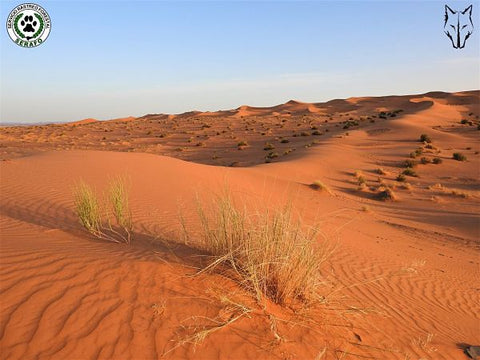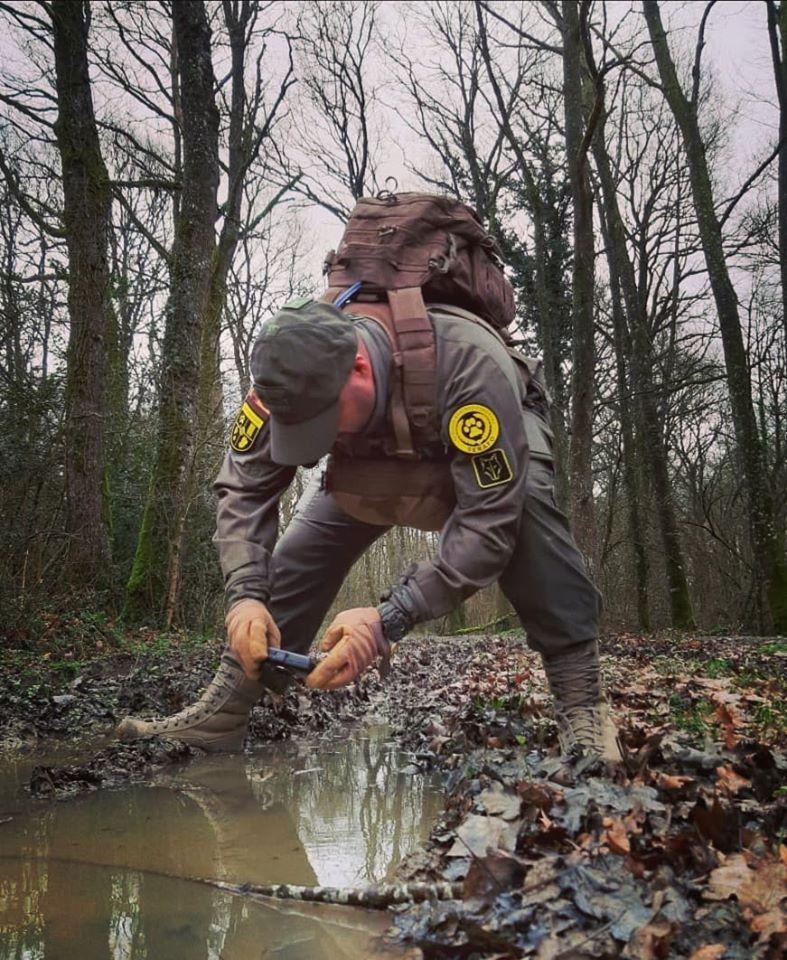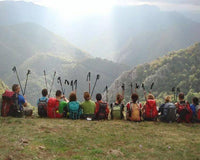TRACKING AND OBSERVATION OF WILDLIFE, THE ORIGINS
We believe that tracking emerged at the same time as human beings themselves, forming an essential part of their evolutionary history, becoming a vital tool for survival. It may even have emerged earlier in the different stages of change we follow in the evolutionary process.
In the beginning, tracking consisted of the perception of different natural signals, the correct interpretation of which brought transcendental benefits to man.
Looking carefully and attentively puts all our senses in receiver mode and through them we capture sounds, images, smells... These stimuli are received by the brain and if "emotion" has been involved in the observation, a survival situation for example or a hunting scene, learning appears and the information received is fixed in our long-term memory as an experience, remaining there in the internal catalog for when we need it.

Photo 1: Corn bunting singing on its perch. Sound signal.

Photo 2: American crab trail.
Our ancestors actively searched for food by tracking , whether by capturing small invertebrates hidden under stones or among vegetation, searching for nests to obtain eggs, or locating carrion by observing the behavior of other animals.

Photo 3: Elephant carcass in Kenya, food for scavengers.
*Photo courtesy of David Ezcurdia
Later, tracking becomes even more necessary when what some authors consider the first hunting modality appears: persistence hunting or uninterrupted hunting. But tracking also allows us to locate dens and burrows and determine whether they are active, allowing us to capture the animals inside. It also facilitates the location of game that has escaped injury when hunted with throwing weapons, and increases the success of trapping.

Photo 4: Sumatran rainforest indigenous person obtaining larvae as food.
Likewise, by tracking , humans could avoid animals they considered prey and therefore posed a lethal threat. Likewise, observing the environment could reveal an area with potentially poisonous fauna, another major danger in many parts of the world.

Photo 5: Armenian viper (Vipera raddei), the most poisonous in Europe.
The constant stress of obtaining food and not becoming it was what marked the daily life of the first species of Homo . This meant that their brain activity was very active, receiving high levels of stimuli that they had to manage quickly and efficiently.
“Being alert and capturing a sound, an image, or a smell, followed by observation to make a deduction, is the basic chain that all wildlife tracking and observation activities require.”
In these complex circumstances, tracking implied the possibility of problem-solving. The perceived stimuli required the continuous formulation of hypotheses, many of which resulted in correct deductions, which not only meant another day of life, but also the perfect breeding ground for continuous, growing, and, above all, vital learning.
We can consider Homo erectus as the prime candidate for the hominid with whom tracking began to develop in Africa, and who later colonized the world to this day. If we accept this reference as the origin of tracking, we could affirm that this activity has a history of almost two million years that has left its mark on our genetic heritage.
THE EVOLUTION
From that Homo erectus to the present day, tracking wildlife (and even people) has gone from what seemed to be simply a purely instinctive animal reaction to becoming a rational, premeditated and reasoned human action, which can and should be trained, and therefore enhanced and improved.
Tracking has been and still is used by Homo sapiens in remote corners of the planet to locate and obtain food. From seemingly empty deserts to dense jungles, numerous tribes have based their survival on interpreting the signs of their environment.

Photo 6: Sahara Desert in Morocco

Photo 7: Lesser Caucasus in Armenia
Locating animals for food is one of the most important applications where tracking and observation are the cornerstones, not only for obtaining large prey, but especially for small animals, such as reptiles and even protein-rich invertebrates. Observing animal behavior and their tracks has led us for millennia to obtain resources beyond just "game." Areas where we can obtain fruits, tubers, water, and fire materials are just some of the examples.

Photo 8: WWF Ranger for the protection of the Persian Leopard (Panthera pardus saxicolor) and SERAFO Tracker.
Locating and observing predators allows us to search for their main prey, the bezoar goat (Capra aegagrus aegagrus). This behavior may have been very common in primitive times, but it persists in some present-day tribes, such as the Maasai, who track lions to steal part of their kills.
Different African ethnic groups, Aboriginal communities in Australia, various indigenous groups in Asia from islands such as Sumatra or Borneo, or from the jungles of Colombia, Ecuador, Peru or Brazil, but above all Native Americans such as the Apaches, have been known internationally for centuries for their tracking skills.

Photo 9: Jicarilla Apache ranger-tracker observing the territory from above
THE KEY
Their bodies and minds are intimately adapted to their environment; they intensely perceive everything around them, and their physical and mental abilities are exceptional. An example of this is the indigenous community of the Rarámuri, also known as the Tarahumara, located in the Sierra Madre Occidental of Mexico. They have demonstrated and maintain the abilities of elite athletes through their control of nutrition, hydration, and physical endurance in hostile environments such as deserts.
An open space, a mind unsaturated by artificial stimuli, freedom from noise pollution, natural lighting, adaptation to natural rhythms, and an optimal diet give this community and other human communities in many areas of the planet high tracking abilities, making them "machines" for navigating and surviving their environments. Furthermore, the traditional method of learning through practice is common among hunter-gatherers, and they often spend time together, chatting, telling stories, and sharing knowledge, especially around the campfire.

Photo 10: Bushmen in Namibia, a great example of the last hunter-gatherer communities on the planet.
*Photo courtesy of Silvia Arriscado de la LLave
Many of the tracking techniques used by these peoples remain effective without major modifications or technological advances. So much so that numerous countries have included these techniques, learned from indigenous peoples, in the basic and mandatory training of nature guides, safari guides, and park rangers, military personnel, police officers, etc., so that they can be applied in their daily work.
FROM NORTHVIVOR
Through our wildlife tracking and observation products, which include training, advice, and future tracking experiences in the wild, we will show you many of these techniques acquired through our own experience with different indigenous communities in the jungles of Colombia, the Colombian-Venezuelan Orinoquia, the jungles of Sumatra, the Sahara Desert with the Berbers, the Jicarilla Apache of New Mexico in the USA, or from different guides, rangers, or scientists from whom we have learned in numerous wild areas such as the Caucasus Mountains in Armenia, Lapland in Finland, or the Rhodope Mountains in Bulgaria.
“ Tracking and observing wildlife is not just another activity to do, but over time it becomes a way of life.”
Author: Fernando Gómez (SERAFO)






